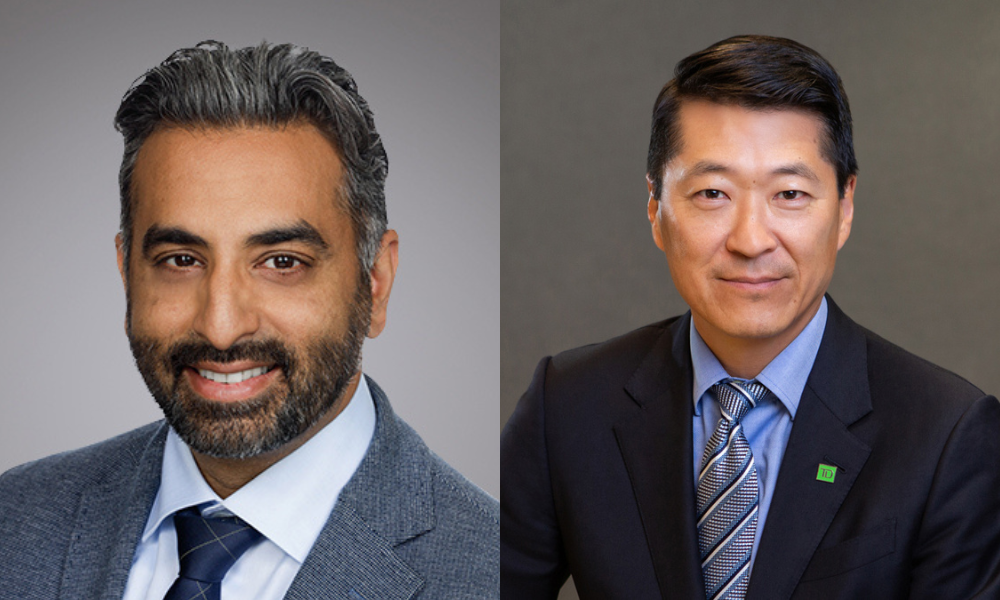Russell Investments also raises their recession risk forecast to as high as 40 per cent after Trump's 'Liberation Day' tariffs

US President Donald Trump has laid the groundwork for another aggressive tariff regime, with institutional investors bracing for renewed economic turbulence.
Trump’s new reciprocal trade levies, this time broader in scope and more uncertain in duration, has sparked concern among pension funds, asset managers, and strategists, who see not just policy risk, but inflationary shock and a rising likelihood of recession.
"It’s difficult to really say with any confidence where this is going to go," said Jafer Naqvi, managing director, head of client portfolio management at TD Asset Management. He emphasized that tariffs are just one expression of a more complex shift in macroeconomic forces.
“It’s not just worried about growth slowdown or continued growth. You have to worry about inflation dynamics within them,” he added.
Naqvi explained that before the pandemic, economic forecasting for institutional investors was largely focused on whether growth was accelerating or slowing. Inflation, he noted, rarely played a significant role in those calculations.
Now, in the years since COVID, that model has evolved into what he called a “three-body problem,” where inflation is weighed alongside growth and contraction. He said the 2022 inflation shock served as a wake-up call, exposing how vulnerable portfolios were to unexpected price surges across asset classes.
Tariffs, in his view, are a smaller-scale reflection of this larger complexity because they could stoke inflation, trigger a recession, or turn out to be relatively inconsequential. But their significance lies in how they add to an already fragile economic balance.
“Our counsel's really been to make sure you have portfolio resilience by ensuring you have investments that are diversified across those three types of scenarios,” he said.
Bryan Lee, vice-president and director, retail client portfolio management at TD Asset Management, believes the opacity around the policy itself heightens its impact.
“What we probably won’t get a lot of clarity on is duration,” he said.
Ultimately, the lack of specificity leaves institutional investors in the dark, forcing them to prepare for volatility more than certainty. That opacity, Lee said, reinforces the case for “a diversified approach.”
Paul Eitelman, chief investment strategist for North America at Russell Investments, said the White House announcement from the Rose Garden underscored a seismic policy shift.
“We estimate the policy could lift the effective tariff rate in the United States by 14 percentage points, and it is likely to impart a stagflationary impulse onto the economy,” he said in a statement.
Russell expects US real GDP growth to dip below 1 per cent in 2025, and core inflation to climb past 3.5 per cent, raising their recession risk forecast to as high as 40 per cent, noted Eitelman.
Yet, amid the economic drag, Eitelman sees some nuance.
“The reciprocal tariffs leave room for the duties to get negotiated away,” he said, noting that countries like Vietnam have already agreed to reduce tariffs on U.S. products.
Additionally, he noted the exemptions separate this reciprocal policy from Trump’s sector-level tariffs like steel and aluminium, automobiles, and others that have yet to be announced, highlighting pharmaceuticals and semiconductors.
“This suggests to us that the sector-level tariffs are likely to be more permanent,” said Eitelman.
Still, Naqvi insists that headline risks should not dominate portfolio strategy. That’s why he asserted plan sponsors to review their asset mix and ensure exposures can handle inflationary pressure, pointing to commodities, and other alternatives like real estate and infrastructure as investments that can perform well during inflationary periods.
Lee reinforced the importance of keeping a long-term mindset even as volatility spikes, underscoring institutional investors “shouldn’t be thinking in terms of years, they need to be thinking in terms of decades,” he said.
He also cautioned against shifting strategies based on speculative moves, recalling how many investors reacted prematurely to talk of capital gains tax changes that ultimately never materialized.
Despite anxiety around Trump’s back-and-forth messaging on tariffs, both underscored that uncertainty doesn’t have to be paralysing. In fact, it can present opportunity.
As Naqvi pointed out, volatile markets often create “market dislocation, where asset prices move to a level that becomes quite attractive for the long term.” He emphasized that’s where institutional investors with diversified and nimble portfolios can capitalize.
“You’re going to have periods of drawdown but having that diversified basket and an investment approach that has agility gives you the ability to rotate and take advantage of opportunities,” he said.
“You don't want all your eggs in one basket, because if that goes south, you can be challenged.”
As for Eitelman and his team, they remain focused on positioning for volatility rather than reacting to it.
“We remain focused on constructing diversified portfolio strategies for our institutional clients into this period of extreme policy uncertainty.”
Both Lee and Naqvi also pointed to market performance, particularly the vulnerability of Canadian pension funds that rely heavily on US equities. With the MSCI World Index now more concentrated than ever in US stocks, many of them tech giants, Naqvi encouraged plan sponsors to reevaluate whether their portfolios remain as diversified as their benchmarks suggest.
“The situation is extraordinarily fluid,” Naqvi said, “but the biggest decision [institutional investors] are going to make is that strategic asset mix.”



